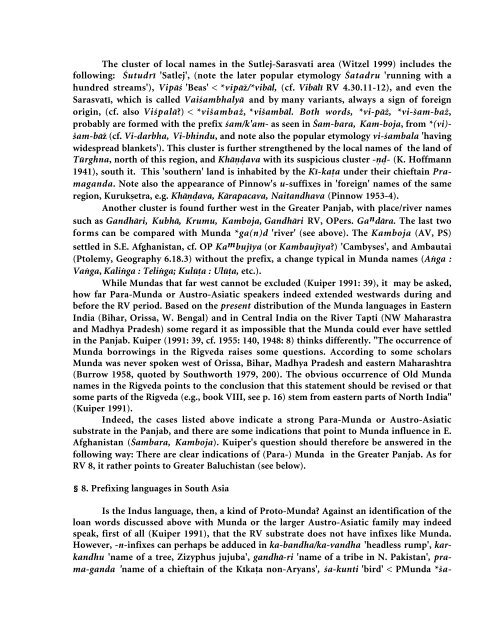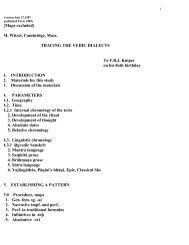The Languages of Harappa - People Fas Harvard
The Languages of Harappa - People Fas Harvard
The Languages of Harappa - People Fas Harvard
Create successful ePaper yourself
Turn your PDF publications into a flip-book with our unique Google optimized e-Paper software.
<strong>The</strong> cluster <strong>of</strong> local names in the Sutlej-Sarasvati area (Witzel 1999) includes the<br />
following: Śutudrī 'Satlej', (note the later popular etymology Śatadru 'running with a<br />
hundred streams'), Vipåś 'Beas' < *vipåž/*vibål, (cf. Vibålī RV 4.30.11-12), and even the<br />
Sarasvatī, which is called Vaiśambhalyå and by many variants, always a sign <strong>of</strong> foreign<br />
origin, (cf. also Viśpalå?) < *višambaž, *višambål. Both words, *vi-påž, *vi-šam-baž,<br />
probably are formed with the prefix śam/k'am- as seen in Śam-bara, Kam-boja, from *(vi)šam-båž<br />
(cf. Vi-darbha, Vi-bhindu, and note also the popular etymology vi-śambala 'having<br />
widespread blankets'). This cluster is further strengthened by the local names <strong>of</strong> the land <strong>of</strong><br />
Tūrghna, north <strong>of</strong> this region, and Khåava with its suspicious cluster -- (K. H<strong>of</strong>fmann<br />
1941), south it. This 'southern' land is inhabited by the Kī-kaa under their chieftain Pramaganda.<br />
Note also the appearance <strong>of</strong> Pinnow's u-suffixes in 'foreign' names <strong>of</strong> the same<br />
region, Kuruketra, e.g. Khåava, Kårapacava, Naitandhava (Pinnow 1953-4).<br />
Another cluster is found further west in the Greater Panjab, with place/river names<br />
such as Gandhåri, Kubhå, Krumu, Kamboja, Gandhåri RV, OPers. Ga n dåra. <strong>The</strong> last two<br />
forms can be compared with Munda *ga(n)d 'river' (see above). <strong>The</strong> Kamboja (AV, PS)<br />
settled in S.E. Afghanistan, cf. OP Ka m bujīya (or Kambaujīya?) 'Cambyses', and Ambautai<br />
(Ptolemy, Geography 6.18.3) without the prefix, a change typical in Munda names (Aga :<br />
Vaga, Kaliga : Teliga; Kulūa : Ulūa, etc.).<br />
While Mundas that far west cannot be excluded (Kuiper 1991: 39), it may be asked,<br />
how far Para-Munda or Austro-Asiatic speakers indeed extended westwards during and<br />
before the RV period. Based on the present distribution <strong>of</strong> the Munda languages in Eastern<br />
India (Bihar, Orissa, W. Bengal) and in Central India on the River Tapti (NW Maharastra<br />
and Madhya Pradesh) some regard it as impossible that the Munda could ever have settled<br />
in the Panjab. Kuiper (1991: 39, cf. 1955: 140, 1948: 8) thinks differently. "<strong>The</strong> occurrence <strong>of</strong><br />
Munda borrowings in the Rigveda raises some questions. According to some scholars<br />
Munda was never spoken west <strong>of</strong> Orissa, Bihar, Madhya Pradesh and eastern Maharashtra<br />
(Burrow 1958, quoted by Southworth 1979, 200). <strong>The</strong> obvious occurrence <strong>of</strong> Old Munda<br />
names in the Rigveda points to the conclusion that this statement should be revised or that<br />
some parts <strong>of</strong> the Rigveda (e.g., book VIII, see p. 16) stem from eastern parts <strong>of</strong> North India"<br />
(Kuiper 1991).<br />
Indeed, the cases listed above indicate a strong Para-Munda or Austro-Asiatic<br />
substrate in the Panjab, and there are some indications that point to Munda influence in E.<br />
Afghanistan (Śambara, Kamboja). Kuiper's question should therefore be answered in the<br />
following way: <strong>The</strong>re are clear indications <strong>of</strong> (Para-) Munda in the Greater Panjab. As for<br />
RV 8, it rather points to Greater Baluchistan (see below).<br />
§ 8. Prefixing languages in South Asia<br />
Is the Indus language, then, a kind <strong>of</strong> Proto-Munda? Against an identification <strong>of</strong> the<br />
loan words discussed above with Munda or the larger Austro-Asiatic family may indeed<br />
speak, first <strong>of</strong> all (Kuiper 1991), that the RV substrate does not have infixes like Munda.<br />
However, -n-infixes can perhaps be adduced in ka-bandha/ka-vandha 'headless rump', karkandhu<br />
'name <strong>of</strong> a tree, Zizyphus jujuba', gandhå-ri 'name <strong>of</strong> a tribe in N. Pakistan', prama-ganda<br />
'name <strong>of</strong> a chieftain <strong>of</strong> the Kīkaa non-Aryans', śa-kunti 'bird' < PMunda *ša-

















